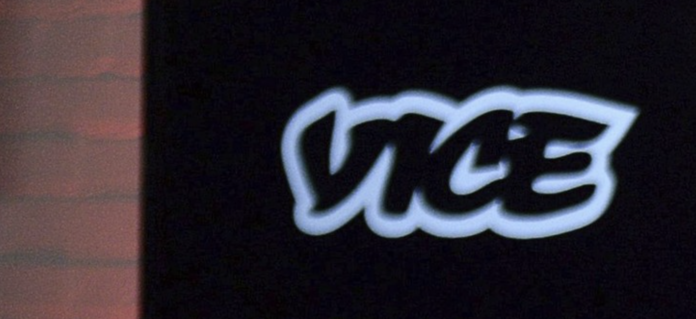VICE Media’s edgy, progressive media made its bones in 2018 by promoting stories on supposed political upstarts such as Katie Hill. It also took advantage of controversial events, like the Charlottesville protests of 2017, using this event to report on white nationalism and other supposedly conservative activism. Disney, HBO and Fox were all after VICE Media’s audience, and they paid a lot of money to get the brand.
This is the present, not then. As legacy media fades, so does this supposed new media face, which has attached itself to a sinking ship. VICE Media is no longer able to sustain itself, following in the footsteps of other co-opted legacy media outlets such as Buzzfeed.
The Wall Street Journal
People familiar with the situation said Vice Media was preparing to declare bankruptcy within the next few days. This would be a dramatic fall for the once hot media startup, valued at $5.7 Billion at its peak.
Vice has been struggling to grow for many years. Its assets include Vice News and Vice TV. Refinery29, Motherboard, and Vice TV. The Wall Street Journal reported that the company was looking to sell but no deal materialized. The company’s former chief executive, Nancy Dubuc left earlier this year. Last week, the company announced that it was restructuring its news division and ending the Vice World News Tonight program and closing down the Vice World News name.
The people stated that it is still possible for Vice to find a buyer, and avoid bankruptcy.
You’re welcome.
A spokesman said in a Monday statement that Vice Media Group had been involved in a comprehensive assessment of strategic options and planning. “The company’s board and all stakeholders are committed to finding the right path for the business.”
Boys and girls, welcome to the new phase of media. One in which audiences choose what they want and watch based on personalities, content, and less on bombast. VICE’s business model is based on an advertising base which doesn’t really matter, and an audience who has moved to better pastures.
Ah, the youth’s inconstancy.
Vice, which started as a punk mag in Montreal nearly three decades ago, has expanded into digital media, TV, and striking deals with Sky and HBO.
Disney, for example, explored a deal worth $3 billion or more to purchase Vice in 2015. Disney declared its $400m investment into Vice worthless in 2019.
Vice was one of a group of digital media startups, such as BuzzFeed, that were threatening to replace legacy media companies by securing millennial audiences.
The media-consuming public, especially younger Millennials or Gen Z, knows that they must find “news” in other ways after the COVID mania and the corporate media’s complicity. Statista reports that social media, podcasts and “other online mediums” are preferred by Millennials and Gen Z. Vice continued to marry legacy media, and like them, it remained behind. They weren’t on the same path in the end. The Wall Street Journal explains that as a result of this, they suffer the same fate as legacy media giants who once vied for their attention.
Vice’s demise is emblematic of new media companies who raised money with high valuations and have struggled to navigate an advertising environment in which the majority of ad dollars are going to Alphabet Google or Meta Platforms Facebook. BuzzFeed announced last month that it would close its news division due to continued losses.
Journal reported that the media company was in arrears with many of its vendors and received a $30m lifeline from Fortress recently to help it through a sales process.
The massive layoffs in the media, the impending bankruptcy of Vice, and the studios forcing writers to strike, as well as the rise of A.I., have all contributed to the current situation. There’s a grotesque undervaluation of creativity and imagination, at a time when people seem to be more desperate than ever for them.
— Otto Von Biz Markie (@Passionweiss) May 2, 2023
Then there is the question of how they handled money. VICE is a leftist media organization that was thinly disguised to look like investigative journalism. Samuel Bankman Fried and FTX were leftist money laundering organizations disguised as crypto companies.
The New York Times has blown the lid off this illusion.
The company has tried to make a profit for many years, but it has failed. It has lost money and has had to lay off staff repeatedly.
It’s hard to be a gonzo journalist without a staff.
Vice announced last week that it would be closing Vice World News. This global reporting initiative covered human rights abuses and conflicts around the world. The closing of Vice World News was a disappointment to many employees, who viewed the aggressive reporting as being in line with Vice’s gonzo journalism roots. Shane Smith reported from North Korea and other risky locations.
Even former fans are spitting on the grave of the outlet. Simon Ostrovsky, PBS’s Special Correspondent, is not feeling the love and has thrown maximum shade at that North Korea hit.
In 2011, I met Shane at a Japanese Restaurant on the Russian-Chinese border. He was one week late for a shoot that I meticulously produced about slave labor in North Korea. He spent the entire meal talking about his gold watches. Who would have thought Vice would fail?
Who? Anyone with eyes, and a mind. The old saying goes that style is more important than substance. Substance will always stand the test time no matter the situation. It is even more true in this new age of digital technology. The key to keeping audiences interested and returning is not how much flashy, chaotic, or free content there is, but rather the actual content, talent and new voices. VICE Media relied on the first and ignored the second.
No one else pays the price.




